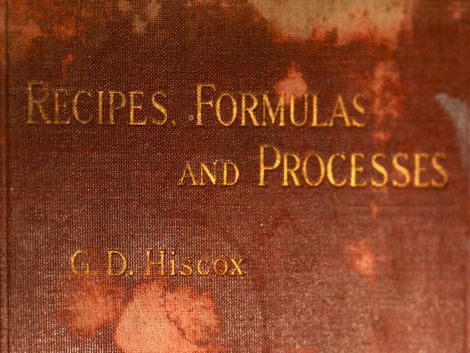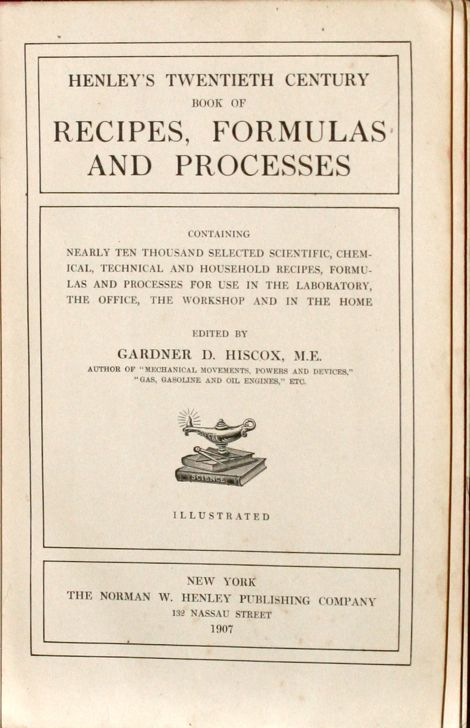Readers interested in early twentieth century chemistry, processes, and tricks of the trade used by industry and in the home, might like to check out the online edition of Henley’s Twentieth Century book of Recipes, Formulas and Processes, Edited by Gardner D.Hiscox – a pdf of Cornell University’s 1909 copy at the Internet Archive.

I’m lucky enough to own a 1907 first edition of Hiscox’s classic work, and love the way my copy is dis-colored and bleached by chemical splashes. Not by me, I hasten to add. But this book has for sure been used for its intended purpose! Whether the former owner, a James McQueen Jr. according to the bookplate, lived long and prospered because of its secrets, or in spite of them, is a different matter.
Secrets intended for all; the preface:
In compiling this book of formulas, recipes and processes, the Editor has endeavoured to meet primarily the practical requirements of the mechanic, the manufacturer, the artisan, and the housewife.
Some of the information is innocuous enough. You can learn how your great grandmother made blackberry jam. And Celery Clam Punch or Cherry Phosphate (with real phosphoric acid, maybe the origin of cherry coke?) sound refreshing for a summer evening.
But some of the medical cures are distinctly dodgy. We worry enough today about tanning products, but Hiscox’s cure for a tan, made from bichloride of mercury, sounds lethal. Helpfully, he shares with us that:
This is not strong enough to blister and skin the face in average cases.
Phew, good job most folk are average. Responsibly, he adds:
Do not forget that this last ingredient [the mercury compound] is a powerful poison and should be kept out of the reach of children and ignorant persons.
Folk would have taken Hiscox’s Cannabis indica based cure for corns in their stride (ouch!). And concern over the pinch of cinnabar in his nail polish would be just another case of health and safety gone mad.
But surely, even by the standards of the time, Hiscox’s idea of a light-hearted party trick must have raised some eyebrows (or literally blown them off): like ‘To take boiling lead in the mouth’, ‘Biting off red hot iron’, ‘Sparks from the finger tips’. And ‘The burning banana’ doesn’t bear thinking about.

Some recipes were probably safe, but just sound a little icky. Like a nice pomade for sir’s hair, made from vaseline oil and beef marrow. Blue hosiery dye called for some ingredients I’ve never heard of: like 4 pounds of Guatamala and 3 pounds of Beugal Indigo; and others I have heard of: like 1 pail of urine. Hiscox also contains lots of paint and ink recipes but, disappointingly, there’s no mention of the infamous Mummy Brown.
‘Solid Alcohol’ sounds quite useful, maybe as a firelighter. I made something similar as a schoolboy, by dissolving soap in methylated spirit.
There’s nothing in Hiscox to separate the domestic from the industrial. Content is alphabetically indexed, but otherwise all mixed up. The section on glass includes industrial formulas for making different glass types and colourings in the furnace, but also includes instructions for a home-made glass grinding device.
Interestingly, Recipes, Formulas And Processes was republished through many revisions and editions into at least the 1930s. But I’m sure today there is nothing quite like it – unless we include the internet as a whole.
On another tack, it’s worth remembering that when Hiscox was published, the welfare and commercial infrastructure we take for granted today (some of us) was much less developed or non-existent. No popping down to the mall for a ready-made solution to every task. Folk just did more of their own stuff.
And should you decide to do more of your own stuff, don’t do it from Hiscox! He’s academically interesting to browse, but clearly some of his recipes and ideas are best left well alone.
Cherry Phosphate (with real phosphoric acid, maybe the origin of cherry coke?)
Indeed in the 1940’s I frequently sat at the soda fountain in a drug store at the intersection of Broadway Ave. and Brand Blvd. in Glendale, CA, and drank cherry phosphates. Cherry coke tastes about the same but not nearly as zesty. I am thankful that I still have all of my teeth at age 75.
Cheers, Jim
Thanks Jim,
I believe they still use phosphoric acid in coke today. There is a popular myth that an iron nail will dissolve if left in coke for a few days; could be true – worth an experiment maybe.